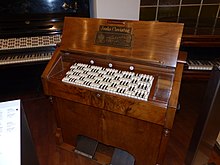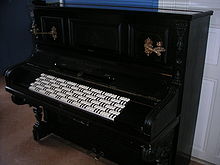Jankó keyboard

The Jankó keyboard is an alternative keyboard shape in the 6-plus-6 arrangement, which was designed by Paul von Jankó in 1882 .
Emergence
Jankó adapted his piano keyboard to the needs of humans in physiological and mnemonic terms, since a normal-sized hand on the usual piano can hardly grasp more than a ninth and different scales require different fingerings and the arrangement of the keys does not correspond to sound and movement the acoustic laws that are valid for every tone cannot be made tangible here with all the senses. This is why his piano has two manuals, one behind the other, with three pressure points for each key lever. Instead of the traditional arrangement of black and white keys in a row, this design has a cluster-like keypad arrangement. In the vertical view the keys are a semitone apart and horizontally a whole tone. As a result, in contrast to the normal piano, all chords and scales have the same fingerings and the same fingering on the keys, regardless of the key you are in. Also with the Jankoklavier there is always congruence between sound and movement, since the acoustic overtone laws that apply to any tone (one octave higher = half the string length, a fifth = 2/3 string length etc.) and thus its network of relationships to the other tones follow the same regularity of every note can be "grasped" in the truest sense of the word, as well as seen and heard. Every listener recognizes a transposed melody as a repetition that has been changed in "color". In conventional pianos, this proportional identity of the acoustic tone relationships is obscured by different fingerings. Something that sounds the same has to be fingered differently and what is grasped the same (e.g. D minor chord and C major chord) sounds different (with the standard keyboard). The Janko keyboard offers grip variations depending on the hand size, but the selected grip shape then applies to all keys and a major grip is never the same as a minor grip, so that different acoustic events also mean different grip patterns. The music itself, as it is perceived by hearing, therefore corresponds to the Janko keyboard, with which the hearing is therefore always involuntarily trained through constant sound-grip association. Jankoklaviere were initially quite common and were also made by well-known manufacturers such as Steinway & Sons , Bechstein , Blüthner , Ibach etc. pp. manufactured.
The most important reason for the failure to continue the initially meteoric success in the production of Jankoklavieren was the short durability of the instruments. However, this was mainly due to the routine of piano making: piano makers continued to build Janko keys and their levers out of wood with a pen guide, instead of using a more suitable material such as aluminum with axles at the wagon points to match the requirements of the increased progress in piano playing and virtuosity due to the Janko possibilities. The Janko instruments that still exist in museums prove that Janko instruments quickly wore out if a construction took over the routines of the construction of conventional pianos; this applies in particular to pin guides at the carriage point of each key lever (or lower lever in Jankoklavieren with double levers), because the narrower scale of the The entire keyboard also requires much narrower keys, which now require axle constructions. Soon ended due to constant costly maintenance. The disappointments of the pianists at having made high financial investments in vain without having a durable instrument for them have fundamentally brought the Janko idea into disrepute.
Technical advancements
The length of the octave is 120 mm compared to approx. 165 mm for the normal keyboard. Thus, instead of the usual 123 centimeters, the keypad is only 89 centimeters wide, which, due to the spreading of the key levers on the strings, leads to signs of wear, even at the wagon point and with straight lower levers and the like. a. also at the points of application of the force and the load (also on the pilot) and thereby causes late follow-up costs that contributed to the initial failure of the invention. Only the “Boyes lever” solved these problems. The friend Jankós and president of the Jankovereins, Dr. Francis Bryan Boyes, (the Jankoverein existed in Vienna long after his and Janko's death until July 9, 1965) presented him in his piano building instructions "The Jankó-Clavier in its perfect execution and the question of its right to exist: explained by illustrations, if possible brief and at the same time exhaustive treatment of this subject ", Vienna 1894 and demonstrates here also with illustrated evidence (e.g. page 5) the durability of its aluminum construction, which u. a. also by means of axes, instead of the conventional pins on the carriage point of the button lever, planned obsolescence is excluded. In 2005, after twenty years of research, the founder of the Jankoinstitut (destroyed in 2012) succeeded in presenting a design as the best for Jankoklaviere, in which a "Pfeiffer upper lever" design (see Museum Stuttgart) is combined with the Boyes lever. The Pfeiffer upper levers allow the same stroke and the same effort from each of the three stop points of each Janko key. The Boyes levers are maintenance-free. Since the original plans of the Pfeiffer design were lost during the war, piano builder Peter Zettel, together with the Jankoinstitut founder and pianist Detlef Graul, disassembled the Pfeifferjankoklavier in the Museum Stuttgart and in 2005 created a plan that was based on the address of the former Jankoinstitut (Neufraerstraße 25, 78554 Aldingen-Aixheim) is to be obtained.
variants
Many special versions of this piano were created after Jankó had designed it. Jankó himself developed a key arrangement that resembled the small, narrow, black and white keys of the well-known piano, and patented this in Germany in 1884. In the following year, he patented the wider cheekbones with the advantageous round shape typical of Jankó. Other inventors applied for patents and applied for other design proposals that were similar to Jankós and often differed only in the shape of the keys (to be named are: Edgar, Cramer, McChesney, Stewart, Adams, Nordbö, Barnett, Reuther and Firestone). In addition to instruments that also follow the 6 plus 6 principle, Johannes Beyreuther provides a notation that has been optimized for this .
Even today, numerous new variations such as B. from Daskin, Lippens, Chromatone etc. pp. The Jankó design is currently mainly used by manufacturers of electronic instruments. Since 2000 the Jankó keyboard production has been resumed by several piano and keyboard manufacturers. a. again from Bluethner, Aug. Laukhuff , Kluge.
reception
At the time of its invention, the instrument was hailed as revolutionary. Arthur Rubinstein said about the Janko keyboard: "If I were to begin my career anew it would be on this keyboard" ( If I had to start my career over, it would be on this keyboard ). Franz Liszt said: "This invention will have replaced the current piano in fifty years!" Almost exclusively full-time star pianists recognized the eminent advantages of the Janko keyboard. For example, the pianist Walter Rehberg, who (as director of the Stuttgart University of Music until 1933) also gave Janko lessons and performed numerous successful concerts on his Jankopfeiffer grand until he fled to Switzerland from the National Socialists.
Contrary to Liszt's prediction and Rubinstein's endorsement, the Jankó keyboard did not catch on, especially since few wanted to learn their repertoire on a non-established piano with new fingerings. It was also of little use if you had rehearsed a piece on the new keyboard, but then had to expect to find a conventional instrument at the concert venue. If the Janko keyboard had been invented earlier, when pianos were still made with lighter wooden frames instead of metal frames, and were thus more portable, the Janko keyboard might have prevailed. But the piano was firmly established in the romantic era and was used and favored by many musicians.
Individual evidence
- ^ Till Stehr: Pianino by Pfeiffer with Jankó keyboard. In: https://www.landesmuseum-stuttgart.de/ . Retrieved August 24, 2020 .
- ↑ a b can be viewed online at http://echo.mpiwg-berlin.mpg.de/ECHOdocuView?mode=imagepath&url=/permanent/library/94543QFP/pageimg
- ^ The Cipher for Whole Tone or Janko Chromatic Keyboard.
- ↑ Chromatone 312 ( Memento from August 27, 2014 in the Internet Archive )
- ^ The Paul Jankó keyboard.
Web links
- Paul von Jankó, A new keyboard. Publication by Paul von Jankós from 1886
- Paul von Jankó, patent specification - keyboard for keyboard instruments (PDF; 237 kB) from 1883
- Paul von Jankó, patent specification - innovation on the patented keyboard (PDF; 127 kB) from 1885
- Janko keyboard piano. Article from Pianoworld magazine
- The Uniform Keyboard. The possible arrangement of the keys of the piano and Paul von Jankó (English)
- Mouse and PC Keyboard Music. Windows program for implementing different keyboard layouts on the PC keyboard, including that of the Jankó keyboard (English)
- Piano versus accordion incl. 6 + 6 (Janko) Java applets for Windows and Mac: Comparison of two-handed playing in the various systems with the keyboard held vertically.
- Graul's dream has 88 keys newspaper article about a current replica
- Chick Corea - Children's Song No. 17 Audio sample on an electronic Janko keyboard
- Lippens Keyboard - Design Intro

